[1]
V.C. Johansen, L.M. Hills, F.M. Miller and R.W. Stevenson, The Importance of Cement Raw Mix Homogeneity, International Cement, Chicago, USA, online on America's Cement (2003). http://cementamericas.com/mag/cement_importance_cement_raw/.
DOI: 10.1109/citcon.2002.1006501
Google Scholar
[2]
A. Mohamed, and G. Hesham, Variation of Feed Chemical Composition and Its Effect on Clinker Formation–Simulation Process. Proceedings of the World Congress on Engineering and Computer Science, WCECS, 20-22, San Francisco, USA, (2010).
Google Scholar
[3]
A. B. Robert, Effect of cooling rates on mineralization in portland cement clinker, University of Missouri-Kansas, Kansas City, Missouri(2015).
Google Scholar
[4]
Y. Ono, Microscopical observations of clinker for the estimation of burning condition, grindability, and hydraulic activity, Proceedings of the Third International Conference on Cement Microscopy, International Cement Microscopy Association, Houston, Texas, 198-210, (1981).
Google Scholar
[5]
G.W. Ward, Effect of heat treatment and cooling rate on the microscopic structure of portland cement clinker, Journal of Research of the National Bureau of Standards, 26, 49-64, (1941).
DOI: 10.6028/jres.026.035
Google Scholar
[6]
D. H. Campbell, Microscopical examination and interpretation of portland cement and clinker, Portland Cement Association, Skokie, IL, 201, (1999).
Google Scholar
[7]
I. Maki, and K. Goto, Factors influencing the phase constitution of a lite in Portland cement clinker, Cement and Concrete Research, 12, 301- 308, (1982).
DOI: 10.1016/0008-8846(82)90078-3
Google Scholar
[8]
I. Maki, Processing conditions of portland cement clinker as viewed from the fine textures of the constituent minerals. Ceramic Transactions, 40, 3-17, (1994).
Google Scholar
[9]
F. M. Lea, The chemistry of cement and concrete, Chemical Publishing Inc., New York, 1092, (1972).
Google Scholar
[10]
G.W. Ward, Effect of heat treatment and cooling rate on the microscopic structure of portland cement clinker, Journal of Research of the National Bureau of Standards, 26, 49-64, (1941).
DOI: 10.6028/jres.026.035
Google Scholar
[11]
Y. Ono, S. Kawamura, and Y. Soda, Microscopic observations of alite and belite and hydraulic strength of cement. Fifth International Symposium on Chemistry of Cement, Tokyo, 1, 275-284, (1968).
Google Scholar
[12]
Y. Ono, Microscopical observations of clinker for the estimation of burning condition, grindability, and hydraulic activity. Proceedings of the Third International Conference on Cement Microscopy, International Cement Microscopy Association, Houston, Texas, 198-210, (1981).
Google Scholar
[13]
M. H. Zaid, Thermal analysis of the grate clinker cooler. M.Sc. Thesis, University of Kufa, (2002).
Google Scholar
[14]
G. Locher, Mathematical models for the cement clinker burning process, Part 4. Grate cooler [J], ZKG-International, 22 (6), 46-57, (2002).
Google Scholar
[15]
D. Touil, H. F. Belabed, C. Frances, and S. BelaadiHeat exchange modeling of a grate clinker cooler and entropy production analysis, Heat and Technology, 23 (1),61-68, (2005).
Google Scholar
[16]
K. S. Mujumdar, K. V. Ganesh, S. B. Kulkarni, and V. V. Ranade, Rotary cement kiln simulator (RoCKS): Integrated modeling of pre-heater, Journal of Calciner, Kiln and Clinker Cooler, Chemical Engineering Science, 62 (9), 2590-2607, (2007).
DOI: 10.1016/j.ces.2007.01.063
Google Scholar
[17]
X. H. Zhang, J. Y. Zhang, C. D Dai, and D. J. Xie, Optimization and simulation of sinter cooling process, CIESC Journal, 62 (11), 3081-3087, (2011).
Google Scholar
[18]
Y. Wen, N. Li, and B. Liu, Investigation on the heat transfer model of the cement, Bulletin of the Chinese Ceramic Society, 30 (6), 1381-1385, (2011).
Google Scholar
[19]
K. C. Zheng, Z. Wen, X. L. Liu, G. F. Lou, X. Zhang, Y. G. Zhang, W. F. Wu, Investigating the general mathematics model of gas-solid heat transfer in the cooling process of high-temperature clinker and sintered material, Energy for Metallurgical Industry, 29 (2), 27-30.clinker . Bulletin of the Chinese Ceramic Society, 30 (6), 1381-1385, (2010).
Google Scholar
[20]
A. J. Nasr, M. J. ALshukri, W. A. Rasheed, I. Y. Hussain, Numerical investigation of a new cooling method for clinker flow in parallel with airflow at different height ratios, International Journal of Mechanical & Mechatronics Engineering IJMME-IJENS18 (03),1-17, (2018).
Google Scholar
[21]
D. Maziar, S. V Mohammad, and S. Seyfolah, Perturbation analysis of the local thermal non-equilibrium condition in a fluid-saturated porous medium bounded by an isothermal channel, Springer Science+Business Media Dordrecht, Transp Porous Med DOI 10.1007/s11242-013-0267-2, (2014).
DOI: 10.1007/s11242-013-0267-2
Google Scholar
[22]
D Maziar, S. V. Mohammad, S. Seyfolah, Temperature-dependent conductivity in forced convection of heat exchangers filled with porous media: A perturbation solution. Energy Conversion and Management, 91, 259–266, (2015).
DOI: 10.1016/j.enconman.2014.12.011
Google Scholar
[23]
A. Y. Aya, and Y. h. Ihsan, Experimental and numerical investigation of forced convection in a porous medium subjected to constant heat flux. M.Sc. Thesis, University of Baghdad, College of Engr. Mech. Engr. Dept, (2013).
Google Scholar
[24]
Y. Yao, S. Ding, and Y. Chen, Modeling of the thermal e_ciency of a whole cement clinker calcination system and its application on a 5000 mt/d production line, Energies, 13(20), 5257, (2020).
DOI: 10.3390/en13205257
Google Scholar
[25]
Y. K. Verma, B. Mazumdar, and P. Ghosh, Thermal energy consumption and its conservation for a cement production unit, Environ Eng Res, 26(3), (2021).
Google Scholar


